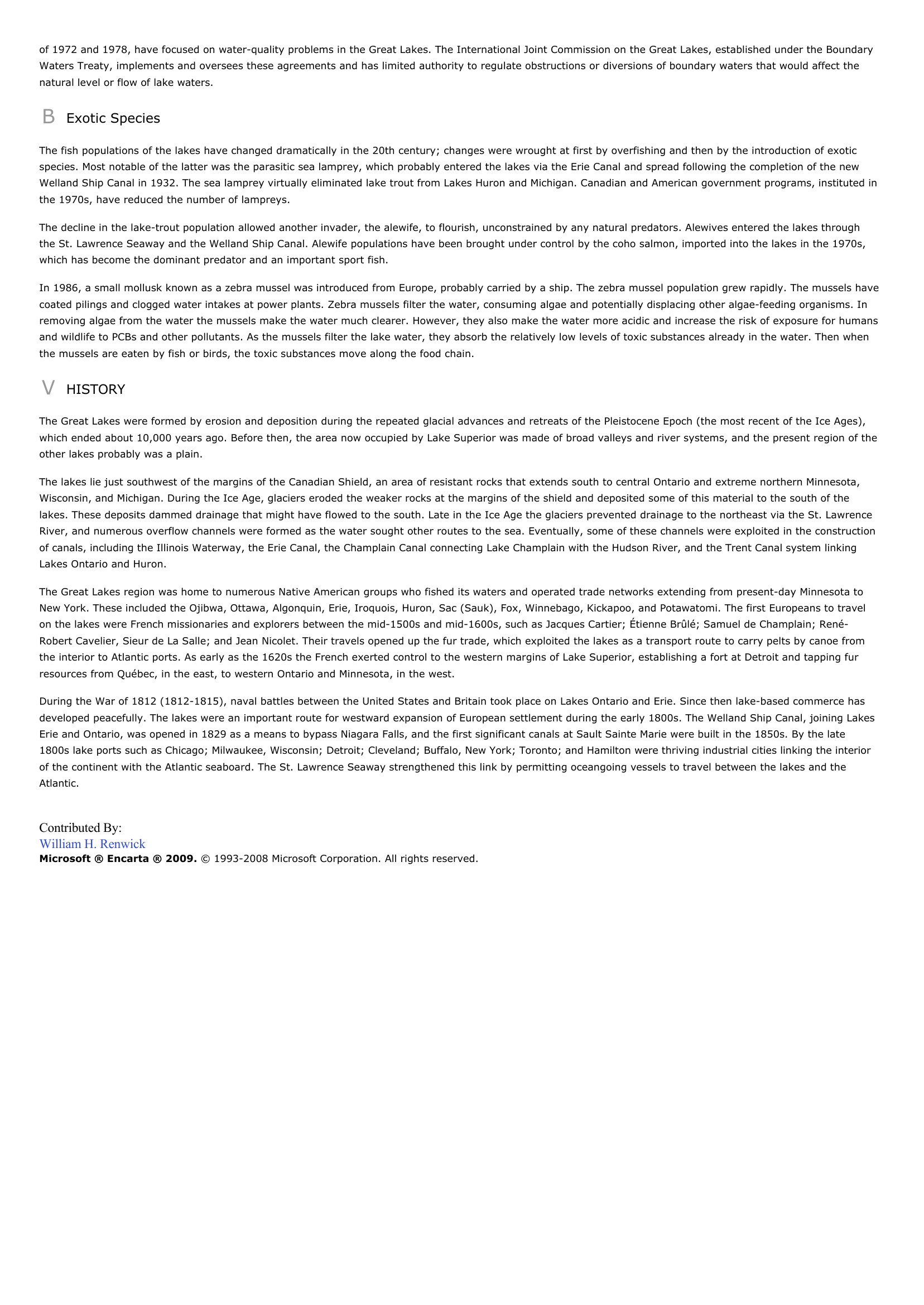Great Lakes - Geography.
Publié le 03/05/2013

Extrait du document
«
of 1972 and 1978, have focused on water-quality problems in the Great Lakes.
The International Joint Commission on the Great Lakes, established under the BoundaryWaters Treaty, implements and oversees these agreements and has limited authority to regulate obstructions or diversions of boundary waters that would affect thenatural level or flow of lake waters.
B Exotic Species
The fish populations of the lakes have changed dramatically in the 20th century; changes were wrought at first by overfishing and then by the introduction of exoticspecies.
Most notable of the latter was the parasitic sea lamprey, which probably entered the lakes via the Erie Canal and spread following the completion of the newWelland Ship Canal in 1932.
The sea lamprey virtually eliminated lake trout from Lakes Huron and Michigan.
Canadian and American government programs, instituted inthe 1970s, have reduced the number of lampreys.
The decline in the lake-trout population allowed another invader, the alewife, to flourish, unconstrained by any natural predators.
Alewives entered the lakes throughthe St.
Lawrence Seaway and the Welland Ship Canal.
Alewife populations have been brought under control by the coho salmon, imported into the lakes in the 1970s,which has become the dominant predator and an important sport fish.
In 1986, a small mollusk known as a zebra mussel was introduced from Europe, probably carried by a ship.
The zebra mussel population grew rapidly.
The mussels havecoated pilings and clogged water intakes at power plants.
Zebra mussels filter the water, consuming algae and potentially displacing other algae-feeding organisms.
Inremoving algae from the water the mussels make the water much clearer.
However, they also make the water more acidic and increase the risk of exposure for humansand wildlife to PCBs and other pollutants.
As the mussels filter the lake water, they absorb the relatively low levels of toxic substances already in the water.
Then whenthe mussels are eaten by fish or birds, the toxic substances move along the food chain.
V HISTORY
The Great Lakes were formed by erosion and deposition during the repeated glacial advances and retreats of the Pleistocene Epoch (the most recent of the Ice Ages),which ended about 10,000 years ago.
Before then, the area now occupied by Lake Superior was made of broad valleys and river systems, and the present region of theother lakes probably was a plain.
The lakes lie just southwest of the margins of the Canadian Shield, an area of resistant rocks that extends south to central Ontario and extreme northern Minnesota,Wisconsin, and Michigan.
During the Ice Age, glaciers eroded the weaker rocks at the margins of the shield and deposited some of this material to the south of thelakes.
These deposits dammed drainage that might have flowed to the south.
Late in the Ice Age the glaciers prevented drainage to the northeast via the St.
LawrenceRiver, and numerous overflow channels were formed as the water sought other routes to the sea.
Eventually, some of these channels were exploited in the constructionof canals, including the Illinois Waterway, the Erie Canal, the Champlain Canal connecting Lake Champlain with the Hudson River, and the Trent Canal system linkingLakes Ontario and Huron.
The Great Lakes region was home to numerous Native American groups who fished its waters and operated trade networks extending from present-day Minnesota toNew York.
These included the Ojibwa, Ottawa, Algonquin, Erie, Iroquois, Huron, Sac (Sauk), Fox, Winnebago, Kickapoo, and Potawatomi.
The first Europeans to travelon the lakes were French missionaries and explorers between the mid-1500s and mid-1600s, such as Jacques Cartier; Étienne Brûlé; Samuel de Champlain; René-Robert Cavelier, Sieur de La Salle; and Jean Nicolet.
Their travels opened up the fur trade, which exploited the lakes as a transport route to carry pelts by canoe fromthe interior to Atlantic ports.
As early as the 1620s the French exerted control to the western margins of Lake Superior, establishing a fort at Detroit and tapping furresources from Québec, in the east, to western Ontario and Minnesota, in the west.
During the War of 1812 (1812-1815), naval battles between the United States and Britain took place on Lakes Ontario and Erie.
Since then lake-based commerce hasdeveloped peacefully.
The lakes were an important route for westward expansion of European settlement during the early 1800s.
The Welland Ship Canal, joining LakesErie and Ontario, was opened in 1829 as a means to bypass Niagara Falls, and the first significant canals at Sault Sainte Marie were built in the 1850s.
By the late1800s lake ports such as Chicago; Milwaukee, Wisconsin; Detroit; Cleveland; Buffalo, New York; Toronto; and Hamilton were thriving industrial cities linking the interiorof the continent with the Atlantic seaboard.
The St.
Lawrence Seaway strengthened this link by permitting oceangoing vessels to travel between the lakes and theAtlantic.
Contributed By:William H.
RenwickMicrosoft ® Encarta ® 2009. © 1993-2008 Microsoft Corporation.
All rights reserved..
»
↓↓↓ APERÇU DU DOCUMENT ↓↓↓
Liens utiles
- Great Lakes - geography.
- Great Lakes - geography.
- Great Rivers - geography.
- Glacial Lakes - geography.
- Great Wall (China) - geography.












